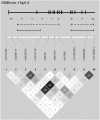Family-based association study of ITGB3 in autism spectrum disorder and its endophenotypes
- PMID: 21102624
- PMCID: PMC3062005
- DOI: 10.1038/ejhg.2010.180
Family-based association study of ITGB3 in autism spectrum disorder and its endophenotypes
Abstract
The integrin-β 3 gene (ITGB3), located on human chromosome 17q21.3, was previously identified as a quantitative trait locus (QTL) for 5-HT blood levels and has been implicated as a candidate gene for autism spectrum disorder (ASD). We performed a family-based association study in 281 simplex and 12 multiplex Caucasian families. ITGB3 haplotypes are significantly associated with autism (HBAT, global P=0.038). Haplotype H3 is largely over-transmitted to the affected offspring and doubles the risk of an ASD diagnosis (HBAT P=0.005; odds ratio (OR)=2.000), at the expense of haplotype H1, which is under-transmitted (HBAT P=0.018; OR=0.725). These two common haplotypes differ only at rs12603582 located in intron 11, which reaches a P-value of 0.072 in single-marker FBAT analyses. Interestingly, rs12603582 is strongly associated with pre-term delivery in our ASD patients (P=0.008). On the other hand, it is SNP rs2317385, located at the 5' end of the gene, that significantly affects 5-HT blood levels (Mann-Whitney U-test, P=0.001; multiple regression analysis, P=0.010). No gene-gene interaction between ITGB3 and SLC6A4 has been detected. In conclusion, we identify a significant association between a common ITGB3 haplotype and ASD. Distinct markers, located toward the 5' and 3' ends of the gene, seemingly modulate 5-HT blood levels and autism liability, respectively. Our results also raise interest into ITGB3 influences on feto-maternal immune interactions in autism.
© 2011 Macmillan Publishers Limited All rights reserved 1018-4813/11
Figures
Similar articles
-
Evidence that ITGB3 promoter variants increase serotonin blood levels by regulating platelet serotonin transporter trafficking.Hum Mol Genet. 2019 Apr 1;28(7):1153-1161. doi: 10.1093/hmg/ddy421. Hum Mol Genet. 2019. PMID: 30535103
-
Evidence for epistasis between SLC6A4 and ITGB3 in autism etiology and in the determination of platelet serotonin levels.Hum Genet. 2007 Apr;121(2):243-56. doi: 10.1007/s00439-006-0301-3. Epub 2007 Jan 3. Hum Genet. 2007. PMID: 17203304
-
Genetic association and gene-gene interaction analyses suggest likely involvement of ITGB3 and TPH2 with autism spectrum disorder (ASD) in the Indian population.Prog Neuropsychopharmacol Biol Psychiatry. 2013 Aug 1;45:131-43. doi: 10.1016/j.pnpbp.2013.04.015. Epub 2013 Apr 28. Prog Neuropsychopharmacol Biol Psychiatry. 2013. PMID: 23628433
-
ITGB3 shows genetic and expression interaction with SLC6A4.Hum Genet. 2006 Aug;120(1):93-100. doi: 10.1007/s00439-006-0196-z. Epub 2006 May 24. Hum Genet. 2006. PMID: 16721604
-
The genetics of autism.Pediatrics. 2004 May;113(5):e472-86. doi: 10.1542/peds.113.5.e472. Pediatrics. 2004. PMID: 15121991 Review.
Cited by
-
Music genetics research: Association with musicality of a polymorphism in the AVPR1A gene.Genet Mol Biol. 2017 Apr-Jun;40(2):421-429. doi: 10.1590/1678-4685-GMB-2016-0021. Epub 2017 May 22. Genet Mol Biol. 2017. PMID: 28534928 Free PMC article.
-
Integrin β3 organizes dendritic complexity of cerebral cortical pyramidal neurons along a tangential gradient.Mol Brain. 2020 Dec 14;13(1):168. doi: 10.1186/s13041-020-00707-0. Mol Brain. 2020. PMID: 33317577 Free PMC article.
-
p38α MAPK signaling drives pharmacologically reversible brain and gastrointestinal phenotypes in the SERT Ala56 mouse.Proc Natl Acad Sci U S A. 2018 Oct 23;115(43):E10245-E10254. doi: 10.1073/pnas.1809137115. Epub 2018 Oct 8. Proc Natl Acad Sci U S A. 2018. PMID: 30297392 Free PMC article.
-
Neuroanatomical Assessment of the Integrin β3 Mouse Model Related to Autism and the Serotonin System Using High Resolution MRI.Front Psychiatry. 2012 Apr 26;3:37. doi: 10.3389/fpsyt.2012.00037. eCollection 2012. Front Psychiatry. 2012. PMID: 22557981 Free PMC article.
-
Blood platelet research in autism spectrum disorders: In search of biomarkers.Res Pract Thromb Haemost. 2019 Jul 16;3(4):566-577. doi: 10.1002/rth2.12239. eCollection 2019 Oct. Res Pract Thromb Haemost. 2019. PMID: 31624776 Free PMC article. Review.
References
-
- American Psychiatric Association American Psychiatric Association: Diagnostic and Statistical Manual of Mental Disorders4th edition.Publisher; 1994
-
- Persico AM, Bourgeron T. Searching for ways out of the autism maze: genetic, epigenetic and environmental clues. Trends Neurosci. 2006;29:349–358. - PubMed
-
- Klauck SM. Genetics of autism spectrum disorder. Eur J Hum Genet. 2006;14:714–720. - PubMed
Publication types
MeSH terms
Substances
LinkOut - more resources
Full Text Sources


